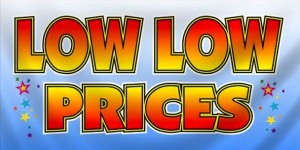 We’ve all seen the trick where something is priced for a penny less than what it could be; in stead of charging $50 they charge $49.00. Gas stations even increment things down to tenths of a cent. Â The weird thing is, this strategy works of they’d stop using. This is an example of what I call a pricing trap. A psychological trick to make think you’re paying less, or getting a better deal than you really are.
We’ve all seen the trick where something is priced for a penny less than what it could be; in stead of charging $50 they charge $49.00. Gas stations even increment things down to tenths of a cent. Â The weird thing is, this strategy works of they’d stop using. This is an example of what I call a pricing trap. A psychological trick to make think you’re paying less, or getting a better deal than you really are.
An “anchor” is an item in a list of options that is designed to set the upper bound of buying options in order to manipulate you into paying more than you normally would. Supposed you sit down at a restaurant and see a steak for $50. Well, that seems a bit high, but there’s another steak for $25. You reasonably decide to go for the $25 option because it looks like a better deal. It’s not, of course, but having that $50 “anchor” temporarily skews your perception of what is “cheap.” It’s amazingly effective. The way to fight this is to have your own personal anchors that you can use to make your own scale. Suppose there is some activity that you really like to do that costs $25. Golfing, going to a show, whatever. Now, when you are faced with a $25 purchase ask yourself, “Am I going to enjoy this as much as [insert favorite $25 activity here]?” Another thing to notice, especially next time you are in a restaurant is that many menus don’t have dollar signs on the prices. They don’t want you thinking about money, so many menus lose the dollar signs.
Another trick deals with our aversion to loss. In one of the classes at the Columbia Business School they do an experiment in which they ask randomly selected people how much they would pay for a simple coffee mug. The average is around $4. But when they give that same mug to other randomly selected groups and then ask them how much they would have to be paid in order to give up that mug, the answer averages around $8. Simply owning something increases its value to most people.
What does this have to do with prices? People don’t like to “lose” something once they have it. This is why flat-rate services are more popular than pay-as-you-go. Cell phone plans are an excellent example of this. Nobody likes to talk on the phone while having to wonder how much the call is going to cost them. In fact, most people do not use all their flat-rate plan minutes each month, which means that they are spending more than they need to. This fear of loss has many, many different variations but the end result is buying more than we need. Think about this before buying that second (or third!) car or buying a house instead of renting.
Make a point of looking at prices you encounter and thinking carefully about the value you stand to get from purchases. It really is true that most buying decisions are made out of emotion; that’s one of the reasons why shopping is an emotional outlet for some people. It’s also why marketers constantly appeal to emotions and sentiment rather than rigorous rational analysis to sell their wares and services. You will get caught by these and other traps, but if you can learn to avoid the ones you spot, it will save you some money and perhaps make your life less cluttered.

